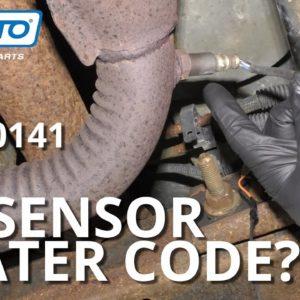In this vehicle, we have a check engine light
on and we have a code with a P0141. In this video, I'm going to give you some
tips on what to check before you just go replace the O2 sensor. This represents the O2 sensor we have in this
vehicle. Some O2 sensors are a little bit different. This is a four-wire setup. So this is where the O2 sensor is going to
read the gas.
The sensor is going to be in the exhaust. And here's the body of the O2 sensor, and
here's the wires. Now, these two wires are signal wires, they're
just going to go to the PCM and tell the PCM what it sees. Now, when you first start up the vehicle,
the O2 sensor is cold and it's not going to send good readings to the PCM because it needs
to be warm. So, what they do is they send power and ground
through the other two wires. And inside the O2 sensor, there's actually
a heater to heat up the O2 sensor to make it work quicker. What our code represents is the fact that
this heater is not heating up. These wires are broken somewhere.
So whether the O2 sensor's broken, or whether
something before the power and ground is broken, that's what we need to figure out. So how did these circuits get their power
and ground? Well, the power circuit goes through the fuse
box, which is commanded on when the key is on. And for the ground circuit, it goes through
the PCM. And when PCM wants to ground this and turn
the heater on, closes the switch and goes to the ground. So the first thing we want to check is the
fuse. Remember, you want to have the key in the
on position. You don't have to have the vehicle running,
just in the on position. I have my test light on the negative lead. Just double-check your test light, make sure
it's good, lights up. For this vehicle, we have two O2 sensor fuses. We have one that's right here, O2 sensor 1
or A and just check both sides of the fuse.
It looks good. And then O2 sensor B, which is right here,
and those are both good. So that's good. It's good to check both of them either way. So now we need to locate where the O2 sensor
is that we are having the problem with. Now, this vehicle has four O2 sensors. There's two on the driver side, two on the
passenger side. Now, the ones in front of the cat converter
are the sensor 1s. So this would be Bank 1, Sensor 1. And then behind the cat converter is Bank
1, Sensor 2. Now, on the passenger side, we have the Bank
2 O2 sensors, so Bank 2, Sensor 1. And then back here would be Bank 2, Sensor
2. So based on our code, we have a Bank 1, Sensor
2 sensor on this vehicle. It's right here. So take a look at the wires, and it looks
like it's chafing right here. It doesn't look like any of the wires are
broken into in there but that is something to look at. Look at the connector, disconnect the connector. See if any of those terminals are green, or
look like they're spread apart.
You might have to do a drag test on those
terminals. But visually, they look okay. With the key still on, I'm gonna put my test
light on a ground right here, anything metal that you can get to. And we want to test the pink circuit. So find the pink wire, so that's right there,
and just lightly touch the terminal and my test light lights up. So that means everywhere from here through
the fuse is working properly.

So that's good. So now we know we have power right there,
so this entire circuit is good. So now we want to test this circuit. Now, we need to start the vehicle and test
right here at this location. What we could do is test it with a multimeter
and just put one terminal here and then one on a ground and check the resistance. It's not as accurate as if you just use a
test light. Now, I'll take one end and put it on the positive
side and the other end right here, and we start the vehicle up. And if the light turns on, then we know this
circuit is good. So now I'm looking for the black and white
wire, which is located right there. So that's this terminal here. So I'm going to take a jumper wire and slide
it in there. Connect this side to the positive side on
the battery, connect my jumper wire to this end of the test light and I'll start the vehicle
and let's look for a light. And that's what it's supposed to do. It's gonna pulse.
So, that's working properly. So the test light lit up when we tested it
right there, so that means everything in this circuit is working properly. So that's good. The power source is good. That means the heater control in the actual
O2 sensor is bad. Something in here is broken right there, and
the O2 sensor needs to be replaced. Okay, so a couple other scenarios. Let's say you tested the PCM circuit and it
didn't work, what's wrong with it? Somewhere in the wiring, could be a break,
somewhere internal in the PCM could've break, or even after the PCM, there could be a break
in a wire there. So that's some stuff you're gonna have to
look into. Also, on the power side, if that didn't test
properly, somewhere the wire could be broken here. You could have a blown fuse. Or even before that, there could be something
wrong with the power getting to the fuse box. Another tip to look out for, if you had all
four heater circuit control codes, you got to think that it's probably not that you need
four O2 sensors.
There's probably something else going on. For instance, if you have an aftermarket remote
starter system, it may not be powering up the circuits to turn this on, and that'll
give you a code. So I hope this video helped you understand
the heater control side of the O2 sensor and how to test it. If you enjoyed this video, make sure you subscribe
to our channel, ring that bell, turn on all notifications so you don't miss any of our
videos.
Thanks for watching. Visit one 1aauto.com for quality auto parts
shipped to your door, the place for DIY auto repair. And if you enjoyed this video, please click
the Subscribe button..

